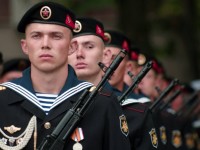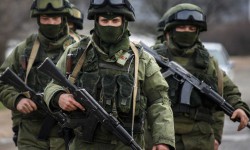The Russian Navy, or Seekriegsflotte called, is a part of the armed forces of the Russian. the navy is divided into 5 districts or fleets similar to the land force:
- Northern Fleet
- Pacific Fleet
- Black Sea Fleet
- Baltic Fleet
- Caspian flotilla
As retaining:
- Naval Aviation
- Marine Infantry
- Coastal Artillery
The strength is about 133,000 men. The ship types are still largely Soviet, but since 2006, far-reaching modernization measures are taking place.
Russian team's ranks
- Матрос (sailor)
- Старший матрос (Upper sailor)
Матрос (sailor) (1), еСтарший матрос (Upper sailor) (2)
Russian noncommissioned officer's ranks
- Старшина 2 статьи (Leading seaman)
- Старшина 1 статьи (boatswain)
- Главный старшина (Upper boat man)
- Главный корабельный старшина (Main boat man)
Старшина 2 статьи (Leading seaman) (3), Старшина 1 статьи (boatswain) (4), Главный старшина (Upper boat man) (5), Главный корабельный старшина (Main boat man) (6)
Russian Mitschman ranks
- Мичман (Mitschmann, similarly rank wo1 to sea)
- Старший мичман (Obermitschmann, similarly rank cw2 to sea)
Мичман (Mitschmann, similarly rank wo1 to sea) (7), Старший мичман (Obermitschmann, similarly rank cw2 to sea) (8)
Russian officer's ranks
- Младший лейтенант (Under second lieutenant)
- Лейтенант (Second lieutenant)
- Старший лейтенант (First lieutenant)
- Капитан-лейтенант (Captain second lieutenant)
- Капитан 3-го ранга (Captain 3. Rank)
- Капитан 2-го ранга (Captain 2. Rank)
- Капитан 1-го ранга (Captain 1. Rank)
Младший лейтенант (Under second lieutenant) (9), Лейтенант (Second lieutenant) (10), Старший лейтенант (First lieutenant) (11), Капитан-лейтенант (Captain second lieutenant) (12), Капитан 3-го ранга (Captain 3. Rank) (13), Капитан 2-го ранга (Captain 2. Rank) (14), Капитан 1-го ранга (Captain 1. Rank) (15)
Russian admiral's ranks
- Контр-адмирал (Countering admiral)
- Вице-адмирал (Vice Admiral)
- Адмирал (Admiral)
- Адмирал флота (Fleet admiral)
Контр-адмирал (Countering admiral) (16), Вице-адмирал (Vice Admiral) (17), Адмирал (Admiral) (18), Адмирал флота (Fleet admiral) (19)
You can find the right literature here:
The Modern Russian Navy
An up-to-date and revised listing of the ships and aircraft in the Russian Navy. More ships and classes of ships making the book bigger, bolder and almost twice as many pages as the first edition. Approximately 300 colour images.
The Russian ASW Guided Missile Cruiser Petropavlovsk
Petropavlovsk was part of the seven-ship unit of the Nikolaev type (project 1134B Berkut), which was a gas-turbine alternative design to the units of the project 1134A. They were classified as large ASW (anti-submarine warfare), although they matched cruisers in size. The primary task of these ships was to search and destroy nuclear submarines in the oceanic zone, in particular, strategic missile submarines.
Due to the requirement of high autonomy and long cruising range, the ships were equipped with a new type of engine in the COGOG (Combined gas or gas) system. It was comprised of two gas turbine units driving two separate shaft lines. Each of the two units consisted of two peak power turbines (20 000 HP each) with a one-speed reduction gear and one sustained turbine (5000 HP) with a two-speed reduction gear. The advantage of the gas turbine was its shorter activation time and greater acceleration. It was also assumed that it would be smaller and more economical than the traditional steam turbine. In fact, it turned out to be a complicated and expensive construction, and, more importantly, quite unreliable.
Russian/Soviet Submarine Launched Ballistic Missiles

Russian/Soviet Submarine Launched Ballistic Missiles: Nuclear Deterrence/Counter Force Strike Paperback – February 4, 2018
In 2017, the sea based element of the Russian Federation nuclear deterrent triad was well advanced in its modernisation with the introduction of Project 955 Borey Strategic Missile Carrier submarines armed with the RMS-56 Bulava submarine launched ballistic missile. The Project 955/Bulava was introduced as a replacement for the Project 677BDR Strategic Missile Carrier submarines armed with R-29RKU-1/2 ballistic missiles and the Project 667BDRM Strategic Missile Carrier submarines armed with R-29RMU1/2/2.1 ballistic missiles. The Project 677BDR was on the verge of retirement whilst the Project 667BDRM was set to serve, in reducing numbers, well into the third decade of the twenty first century and possibly beyond, with an upper out of service date of 2030. The sole operational Project 941U Akula Heavy Ballistic Missile (Submarine) Cruiser remained in service in an operational/trials role with no out of service date announced by the Ministry of Defence of the Russian Federation. The Russian Federation was the major successor state from the dissolution of the Soviet Union in December 1991. This latter state introduced the world’s first submarine launched ballistic missile and submarine based ballistic missile platform to service in 1959, sowing the seeds for four plus generations of missile submarines in Soviet and latter Russian Federation service. It was not, however, until the introduction of the Project 667A, armed, from 1968, with R-27 ballistic missile, that such submarine platforms began to be referred to as Strategic Missile Carriers. The Project 667A was the template for four more Strategic Missile Carrier designs – the Project 667B/BD/BDR/BDRM armed with increasingly capable intercontinental range ballistic missiles of the R-29/R/RK/RM series. These systems were, from 1983, augmented by the Project 941/U Heavy Ballistic Missile (Submarine) Cruisers armed with the R-39/U – the largest and most powerful ballistic missile ever fielded on a submarine launch platform. This volume sets out to document the four generations of Soviet and later Russian Federation submarine launched ballistic missiles carried on the four generations of conventional and nuclear powered ballistic missiles submarines that have served the Soviet and Russian Federation Northern and Pacific fleets since 1959. All technical and historical information has been furnished by the respective design bureaus, manufacturers and the Ministry of Defence of the Russian Federation with additional input from western intelligence agencies.
Russian Navy Handbook Volume 1
Russian Navy Handbook Volume 1 Strategic Information and Weapon Systems
This post is also available in:
 Deutsch (German)
Deutsch (German)  Français (French)
Français (French)  Italiano (Italian)
Italiano (Italian)  简体中文 (Chinese (Simplified))
简体中文 (Chinese (Simplified))  Русский (Russian)
Русский (Russian)  Español (Spanish)
Español (Spanish)  العربية (Arabic)
العربية (Arabic)



















